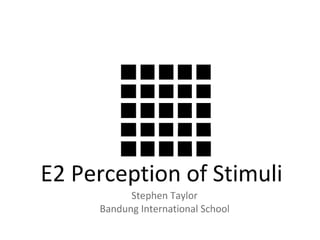
E2 Perception Of Stimuli
- 1. Perception of Stimuli Stephen Taylor
- 12. Processing Visual Stimuli Uses the retina and the brain. The lens focuses light onto the retina at the back of the eye, where it stimulates photoreceptors (rods, sensitive in low light with low acuity; and cones, sensitive to colour in high light, with high acuity). Photoreceptors synapse with bipolar neurons. These feed into ganglion cells, carrying the impulse to the visual cortex through the optic nerve. Some ganglia are sensitive to impulses from the edge of the receptive field, where others are sensitive to impulses from the centre. Edge enhancement (due to lateral inhibition of cells in the retina) results in greater contrast around edges. Stimulus from the left visual field of each eye is processed in the right side of the brain and vice versa. This is due to contralateral processing via the & Davidchiasm http://www.nature.com/nrn/journal/v6/n3/fig_tab/nrn1630_F4.html Thanks to John Burrell optic Mindorff
- 18. Rod Cells Cone Cells Many rod cells feed into one ganglion: all Cone cells feed into their own ganglion. their action potentials are combined into a This gives a small receptive field for each single impulse at the synapse. This means ganglion, leading to high visual acuity – small each ganglion has a large receptive field, but differences are easily detected. low acuity (low ability to detect differences). Rod cells are activated in low light There are three types of cone cells, receptive conditions, but ‘bleached’ in high light to different wavelengths (red, green, blue). intensities. These are only active in sufficient light. They do not detect colour. Cone cells are concentrated in the fovea. Rods are distributed throughout the retina. images adapted from http://www.fujifilmusa.com/products/digital_cameras/exr/eyes/page_03.html
- 19. Receptive Fields and Processing Visual Stimuli Many rod cells feed into one retinal ganglion. This means that many impulse converge to form a single signal which is sent to the brain. There is no distinction between stimuli which hit different sections of the same receptive field. Some ganglia are stimulated by impulses sent from rod cells from the edge of their receptive field and inhibited by signals from the middle. Other ganglia are inhibited by impulses sent from rod cells from the edge of their receptive field and stimulated by signals from the middle. This allows for greater perception of contrast. Edge enhancement also plays a key role. images adapted from http://www.fujifilmusa.com/products/digital_cameras/exr/eyes/page_03.html
- 20. Although each band is uniformly Explaining Edge Enhancement shaded, regions around the edges are enhanced in your vision. appears appears darker lighter Light hits the photoreceptors. More light, more stimulation. In these diagrams, as the receptor cells get brighter, is shows a stronger signal. uniform signal Stimulated photoreceptors pass the action potential to the bipolar neuron and ganglion. retina
- 21. Although each band is uniformly Explaining Edge Enhancement shaded, regions around the edges are enhanced in your vision. appears appears darker lighter Light hits the photoreceptors. More light, more stimulation. Neighbouring cells will inhibit the neurons of each other. Greater stimulation of the receptor means greater inhibition of the neighbours. This is called lateral inhibition. uniform signal If all neighbouring cells receive Stimulated photoreceptors pass the action potential to the the same stimulus (and bipolar neuron and ganglion. therefore inhibition), they will retina produce a uniform signal.
- 22. Although each band is uniformly Explaining Edge Enhancement shaded, regions around the edges are enhanced in your vision. If an edge falls within a visual field, edge enhancement occurs. Receptors receiving a stronger stimulus will inhibit their neighbours more strongly, and vice- versa. So a neuron that is more inhibited than its neighbours will result in a darker colour being perceived (on the dark side of the edge), and uniform weak signal uniform strong signal vice versa, giving an (dark colour perceived) (light colour perceived) enhanced contrast on the border between light and dark images.
- 23. Explaining Edge Enhancement Receptor A receives the A B C D Receptor D receives the same light stimulus as B. same light stimulus as C. Why is B darker than A? Why is C brighter than D? A receives the same weak stimulus as its D receives the same strong stimulus as its neighbours and so is inhibited equally by them. neighbours and so is inhibited equally by them. B is next to C, which recieves a stronger stimulus C is next to B, which recieves a weaker stimulus and therefore inhibits C more. As a result, B is and therefore inhibits C less. As a result, C is overall more inhibited than A, so is darker. overall less inhibited than D, so is brighter.
- 24. It’s more like a gradient… see if you can explain why by annotating the diagram.
- 27. images adapted from http://www.fujifilmusa.com/products/digital_cameras/exr/eyes/page_03.html
- 37. Wheels turning illusion from http://www.newopticalillusions.com/moving-optical-illusions/two-wheels-new-optical-illusion/ @IBiologyStephen Please consider a donation to charity via Biology4Good. Click here for more information about Biology4Good charity donations. This is a Creative Commons presentation. It may be linked and embedded but not sold or re-hosted.
